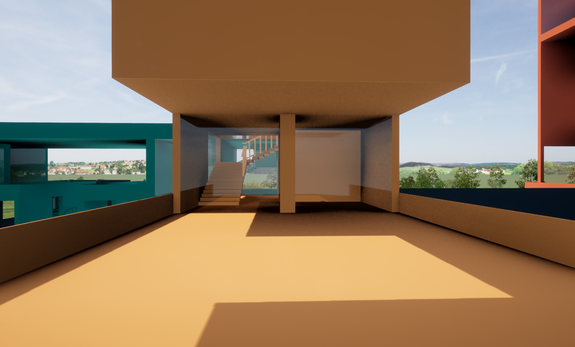
Project Blue Sky | San Francisco 2040
Academic | UCLA | Urban Strategy Studio | Fall 2021 - Winter 2022
Instructor: Jeffrey Inaba & Shaun McCallum
Guerneville | Sonoma County | California
Category: Regenerative Urbanism
Collaboration with: Kamila Khusnetdinova
Project Blue Sky is a sequel to the Orange Sky that occurred in San Francisco back in 2020 during the unprecedented wildfire season across the state.
On this day thousands of acres were ablaze, releasing tremendous amounts of smoke that converged over the bay area from surrounding small towns, mixing with the city’s iconic fog to create a blanket that the sunlight could barely penetrate—only the longer wavelengths of light could get through, bathing the city in a deep orange glow. The typical California sunshine had failed to make an appearance that day.
So, before we start, here’s a short INTRODUCTION of Project Blue Sky.

The cabins that we just saw are housing units & the start point of Project Blue Sky. These prototypes are 3D printed on public lands & then rented out to people for experiencing the new model of living proposed by Project Blue Sky before deciding to be a part of it.
This model of living is a combination of the urban & agrarian life where it brings together housing & co-operative grazing in order to fulfill a larger purpose through communal living & shared management.

The proposed architecture uses only a single T primitive, which is rotated & stacked in different orientations to build a collective form. This primitive exhibits diverse spatial qualities & is connected in various combinations.


In September 2021 for the first time, 10 individual modules were clustered together at various levels to form this multi family housing model. The vibrant colors of the architecture speak for the new ambitions & represent a new model of living.
The T acts as a versatile & promising form & behaves like a parody of former socialist style building. It helps build a town where each house id designed identically to create affordable housing for everyone. This proposal is a playful tribute to the not so playful reality of these towns which burn & are rebuilt to form the same monotonous & bleak townscapes. The overall form helps in creating a larger defensible buffer zone which leads to land management in these wildfire prone areas.
Cluster


The T-Tetris can be moved into different configurations allowing it to adjust & adapt to different needs of people. The 10 individual modules are made to fulfill idealistic but egoistic perspectives in limited space. It competes with the desire & ego of each home owner in the fairest possible way. The vision for these dwellings is to be capable of adapting in real time in response to the wildfires.
Experience in AR


The different key architectural moments being captured in these images here which enable the versatile nature of the overall form.

Walk through it!

Module Intersections
Guerneville, September 2022

Guerneville, September 2021 (Proposed Strategy)

Problems that led to the Orange Sky in 2020

Objectives of Project Blue Sky

How did Project Blue Sky achieve it?
Guerneville back in 2021 had large parcels of private land which were managed by single family homes. This led to inefficient fuel management as the responsibility of managing these large parcels of land was solely on a single family. The objective of Project blue sky was to convert this private management which was an individual responsibility into shared management which would be a shared responsibility amongst multi family homes.
Project Blue Sky is based on a contradiction.....

The New Yorker video below documents what San Franciscans look back on as “Orange Day.” Across the city, disconcerted citizens wandered into the streets and visited hilltop vantage points, trying to capture the sky’s effect with their smartphone cameras—some of which proved too smart for the task, by automatically cancelling out the orange color. Witnesses in the film describe feeling confused and afraid; they compare the conditions to the end of the world, an apocalypse, the inhospitable surface of Mars. And they express worries that this will become more ordinary, that the fires are only going to get worse each year.

Field’s conclusion is unequivocal. “Climate change definitely causes more wildfires, more days when we have wildfires, more days when we have heavy smoke,” he says. Humans often need an unignorable warning before being prompted into action - a siren wailing, a car horn blaring. On this day, the sky itself, blazing biohazard orange, sounded a silent but urgent alarm.
Ever since Project Sky was implemented.....

















